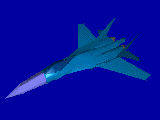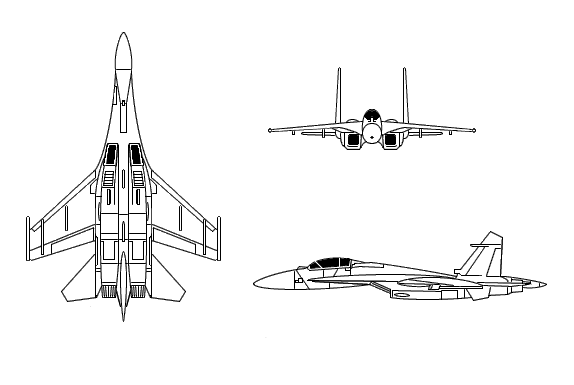




The introduction, in the mid-1970s, of the USAF F-15 Eagle and F-16 Fighting Falcon put the then Eastern bloc fighter pilots at a distinct disadvantage. The deployment of the Su-27 Flanker and MiG-29 Fulcrum in the mid-1980s leveled the playing field. Designed as a high performance fighter with a fly-by-wire control system, and the ability to carry up to 10 AAMs, the highly maneuverable Su-27 is one of the most imposing fighters ever built. The first 'Flanker-A' prototypes flew on May 20, 1977 and entered service as the 'Flanker-B' in 1984. The development of the Su-27 fighter plane was completed in the early 1980s, and the plane subsequently set more than 40 world records of altitude and take-off-speed. It was the forerunner of an entire family of planes, including the Su-27UB training plane, the Su-33 ship-based fighter, the Su-37 multi-mission plane and the Su-32FN two-seat specialised plane. The Su-27UB is a two seat training version of Su-27, which first flew in March 1985.
The Su-27 is in service not only in Russia and other CIS countries but also in China and Vietnam. China also bought a license for the production of its own Su-27 fighters. Sukhoi in 1997 signed an estimated $180-million contract with Vietnam to supply six Su-27 (of which two Su-27SK and four Su-27UB). It supplied four of them in 1996, and two were destroyed when the freighter carrying them crashed into an apartment block in Irkutsk at the end of last year. It is thought that Vietnam plans to buy a total of 24 Sukhoi warplanes for $800 million by the end of the century. By the end of 1997 Sukhoi had passed all of the blueprints over to license production of the Su-27SK in China, and negotiations on the sale of a further 55 Su-27 fighters to China also began.
The wings are mid-mounted and semidelta with square tips. The LERX extends downward and forward of the wing roots. There are two turbojet engines in the fuselage. There are square, diagonally-cut air intakes mounted under the wings alongside the fuselage. The fuselage is rectangular from the air intakes to the tail. The nose is pointed and there is a bubble canopy. The tail fins are swept-back, tapered with square tips, and mounted outboard of the engines. The flats are mid-mounted, swept-back, and tapered.
Specifications | ||
| Country of Origin | CIS (formerly USSR) | |
| Similar Aircraft |
| |
| Crew | one | |
| Role | ||
| Length | 69 ft (21 m) | |
| Span | 47 ft, 6 in (14.5 m) | |
| Armament | up to 6,000 kg payload of missiles and bombs including | |
| In-Flight Refueling | No | |
| Internal Fuel | 6350 kg | |
| Drop Tanks | Drop tank with 1600kg for 126nm range | |
| Payload | 6000kg | |
| Sensors | Flash Dance radar, IRST and TV sensors, RWR, Balistic bombsight | |
| Maximum speed | Mach 2.35 | |
| Maximum weight | 30,000 kg | |
| Ceiling | 15240-18,000 m | |
| Range |
1,500 km combat radius [typical] 1,800 km cruise radius 4,000 km maximum range | |
| PROPULSION | Two 12,550 kg thrust Lyulka AL-31F | |
| User Countries | ||
| VRML 3-D Model |
 Su-27 Flanker VRML by Soji Yamakawa |



